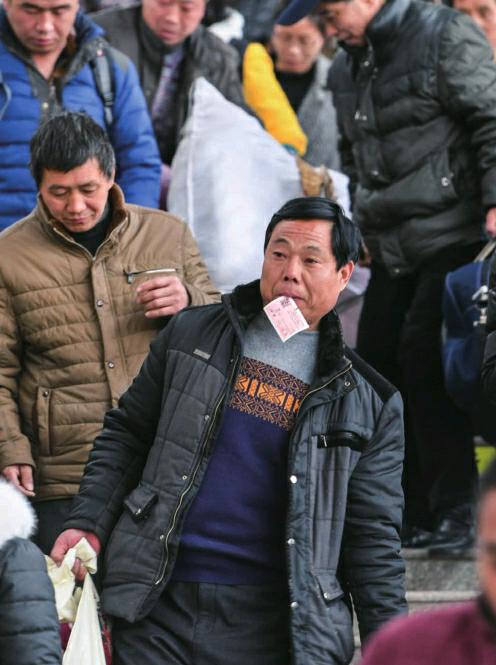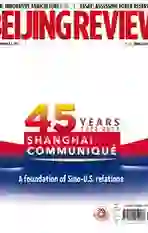LEADING THE RACE
2017-03-29

Gold medalist Wu Dajing of China competes during the mens 500-meter short-track speed skating competition at the Asian Winter Games in Sapporo, Japan, on February 21.
The event, from February 19 to 26, drew around 1,500 participants from 30 countries and regions.
Passengers arrive at Zhengzhou Railway Station in Henan Province on February 21.
The 40-day annual Spring Festival travel rush, known as chunyun in Chinese, ended that day.
This years chunyun saw 2.7 billion trips made by different modes of transportation up to February 20, a drop of around 200 million compared to 2016.
Ecology Observation
A comprehensive monitoring system will be built by 2020 to implement Chinas ecological“red line” strategy and supervise activities inside nature reserves, the Ministry of Environmental Protection (MEP) said on February 20.
This will include a spaceground observation system and an ecological security monitoring system linked up to big data and the Internet, according to MEP.
From this year, authorities will conduct remote sensing monitoring on all national-level nature reserves twice a year, the ministry said.
China has 2,740 nature reserves that cover 1.42 million square km of land, 14.8 percent of the countrys land territory. Among them, 446 are nationallevel reserves, covering 970,000 square km.
The central authorities issued guidelines in February on an ecological “red line” strategy that will make certain regions protected. The zones will be clearly defi ned by the end of 2020.
Food Safety
The State Council on February 21 released two national plans on food and drug safety in 2016-20, promising rigorous standards with strong supervision, accountability and sanctions.
The period will see the full establishment of an effi cient food and drug safety management system, according to the documents.
By 2020, random safety checks will cover all food categories with agricultural pollution sources effectively addressed. There will be at least one safety check on producers and traders per year.
The number and competence of full-time drug quality inspectors should expand to meet demand.
Investment Yield
The annual investment yield for the national social security fund averaged 8.4 percent in the 16 years since it was established, said Wang Zhongmin, Vice Chairman of the National Council for Social Security Fund (NCSSF), on February 20.
Established in 2000, the national social security fund was designed to aid the countrys aging population and be a strategic reserve to support future social security expenditures.
The funding sources include fi scal allocation from the Central Government, allocation from the public welfare lottery proceeds, individual contributions and capital raised by other methods approved by the State Council.
By the end of 2015, the funds managed assets totaled 1.9 trillion yuan ($276.6 billion), according to a report from the NCSSF.
About 54 percent of its assets were invested via entrusted bodies, while 6 percent were invested overseas, said the report.
Registered Copyrights
China received more than 2 million new copyright registrations in 2016, an increase of 22 percent, according to offi cial fi gures revealed on February 21.
Registrations for copyright works accounted for nearly 80 percent of last years total registrations, said the National Copyright Administration.
New software copyright registrations in 2016 doubled from 2014 to 400,000.
Chinas copyright registrations in a single year hit 1 million for the fi rst time in 2013, and totaled 1.64 million in 2015, the administration said.
Poverty Relief
The government will dispatch 18,000 scientifi c and technical workers annually to help poor villagers become technology-savvy in the battle against poverty.
According to a plan drafted by the Ministry of Science and Technology and the State Council Leading Group Offi ce of Poverty Alleviation and Development, mainly underprivileged residents in remote areas or regions inhabited by minority nationalities will benefi t from the arrangement.
The personnel will train about 2,300 people every year and assist in the application of new technolo-gies, so that farmers could increase their incomes and be lifted out of poverty, according to the ministry.
About 100 scientifi c and technological parks will be set up in poor areas to the poverty relief effort, the ministry said.
4G Internet Users
China had 770 million 4G users at the end of 2016, double the number from a year earlier, data from the Ministry of Industry and Information Technology (MIIT) showed on February 17.
More than 58 percent of Chinas mobile phone users were 4G subscribers at the end of 2016, said Zhang Feng, spokesperson and chief engineer of MIIT, at a press conference.
The number of 4G users was 386 million at the end of 2015.
China has the worlds largest 4G network and is aiming to add 2 million 4G base stations, mainly for townships and villages, by 2018.
The country is also researching and testing 5G technology with a goal to commercialize it by 2020.
The research and development work has entered the second phase, according to Zhang, who noted that China will strengthen international cooperation in the process.
Basketball Head
Yao Ming receives his letter of appointment from Li Yingchuan, Assistant Minister of the General Administration of Sport of China, at a ceremony in Beijing on February 23 after he was elected president of the Chinese Basketball Association. Yao, 37, is the fi rst non-governmental person to take the position since the association was founded in 1956.
Affordable Medicine
A generic targeted drug to treat cancer manufactured by a Chinese pharmaceutical company hit market on February 19.
The new gefi tinib cancertreating drug, whose Chinese commercial name is Yiruike, was produced by Qilu Pharmaceutical. Its release ends an almost decade-long monopoly by Iressa, developed by British multinational biopharmaceutical company AstraZeneca and introduced to China in 2005.
A generic drug is a pharmaceutical drug that is equivalent in dosage, strength, quality, and intended use to a brand-name product manufactured by its original developer. Generic drugs often become available after the patent protection on the original drug expires.
Yiruike was approved for marketing by the China Food and Drug Administration after Iressas patent protection expired in April 2016.
The drug is a much-needed fi rst-line medicine used in targeted therapies against non-small-cell lung cancer, which accounts for about 80 percent of lung cancer cases in China.
Ancient Seeds
More than 100 plant seeds dating back 2,000 years have been unearthed from an ancient tomb in north Chinas Inner Mongolia Autonomous Region, archaeologists said on February 17.
According to the regional institute of archaeology, the discovery was made during the excavation of a civilian tomb in Dengkou County.
The half-moon-shaped seeds were found on the eastern side of the female tomb owners head. They gathered in a round shape with a diameter of 8 centimeters. These seeds look like modern pomegranate seeds, but archaeologists have not made a conclusion as to what they are.
A rusted bronze seal was also found in the same tomb and 18 single-chamber brick tombs were also unearthed.
Snowy Landscape
A girl enjoys the snow during a visit to the Palace Museum in Beijing on February 21. A cold front brought snowfall to a large swath of north China that day.
Consumer Inflation Quickens
Chinas consumer infl ation quickened in January due to the effect of the Spring Festival holiday (January 27 to February 2), while prices at factory gates rose faster than expected following soaring oil and gas prices, according to offi cial data released on February 14.
The National Bureau of Statistics(NBS) announced that the consumer price index (CPI), a main gauge of infl ation, grew 2.5 percent year on year in January, fractionally above market expectations of 2.4 percent.
The pace quickened from the 2.1-percent rise in December as the Spring Festival holiday pushed up food, transport and travel expenses, according to NBS senior statistician Sheng Guoqing.
On a monthly basis, consumer prices edged up 1 percent.
Data also showed the producer price index (PPI), which measures costs for goods at the factory gate, grew 6.9 percent year on year in January, beating market expectations and marking a new high in more than fi ve years.
The jump was mainly driven by the carry-over effect of price changes in 2016 and rising prices of raw materials and fuels, the NBS explained.
Prudent, Neutral Monetary Policy
Chinas central bank reiterated on February 17 in a quarterly report that it will implement a prudent and neutral monetary policy while keeping liquidity basically stable.
The Peoples Bank of China(PBOC) said it will work to strike a better balance between stabilizing growth, adjusting structure, curbing asset bubbles and preventing risks, so as to provide a “neutral and moderate” monetary environment for supply-side structural reform.
“The need to balance multiple targets has made monetary policy more diffi cult,” the PBOC said in the report for the fourth quarter of 2016.
China is facing structural contradictions and development pattern issues, it said, adding that in the process of economic structural adjustment, monetary policy should generally be kept prudent and stable.
The bank will also work to boost fi nancial effi ciency and provide better support for the real economy while guarding against systemic risks, said the report.
Top offi cials at the annual Central Economic Work Conference in December 2016 decided that China would maintain a “prudent and neutral” monetary policy in 2017.
The central bank also called for guarding against speculation and unreasonable leveraging, and preventing capital from fl owing out of the real economy, focusing especially on restricting credit from being supplied for speculative real estate purchases.
In a separate statement on fi nancial market regulation on February 17, the PBOC said it will enhance the prudent macro-management of real estate fi nancing, citing Pan Gongsheng, Vice Governor of the PBOC.
To ensure long-term stability and development of the fi nancial market, the central bank will also prevent and address risks in the bond market and the online fi nance market, said Pan.
Cattle Imports
A total of 1,195 live cattle imported from Australia arrive at the Shidao New Port in Weihai, Shandong Province, on February 20, marking a new beginning in live cattle trading following the signing of the China-Australia Free Trade Agreement.
Alibabas New Partner
Chinas leading e-commerce fi rm Alibaba and Shanghai-based retail conglomerate Bailian Group announced a strategic alliance on February 20 to push forward the partnership in “New Retail” formats.
“The strategic partnership will allow Alibaba to put its New Retail concept into practice, changing customer experience and effi ciency of logistics and services,” said Alibabas CEO Zhang Yong.
The alliance does not involve capital ties at this stage.
Bailian Group is a state-owned enterprise in Shanghai. Its main business covers department stores, shopping malls, outlets, large stores, supermarkets and convenience stores, as well as operating in nonferrous metals, ferrous metals, automobiles, chemical lighting, electricity, timber and fuel, etc. It operates 4,700 stores in more than 200 Chinese cities.
Zhang said the two parties had reached a consensus on creating a new shopping experience by using big data.
In a bid to reshape the retail landscape, Chinas e-commerce companies such as Alibaba have been strengthening their presence in offl ine retail channels.
Jack Ma, Alibaba Group Founder and Executive Chairman, said the partnership will trigger a reform in the retail industry. It will integrate online and offl ine businesses to combine tradition with innovation.
Alibabas previous ventures in offl ine retail include its share-swap deal with Suning Commerce Group and a privatization deal to merge with brick-and-mortar retail chain Intime.
Ye Yongming, Chairman of Bailian, said traditional retailing requires technology to provide consumers with new shopping experiences anytime and anywhere.
Consumption contributed 64.6 percent to Chinas GDP growth in 2016 as the country moves from an export- and investment-driven growth model into one that draws strength from consumption, innovation and the service sector.
Retail sales rose 10.4 percent in 2016, slightly down from 10.7 percent in 2015, according to the National Bureau of Statistics.
PPPs Grow Steadily
Chinas public-private partnerships(PPPs) grew steadily in 2016 as project operators experience and effi ciency improved.
A total of 11,260 PPP projects were registered by the end of December, according to a statement released by the China Public Private Partnership Center under the Ministry of Finance.
Among them, 1,351 projects with a total investment of 2.2 trillion yuan($319.7 billion) were signed.
Geographically, southwest Chinas Guizhou Province and eastern Shandong Province are home to the most projects and investment.
As a means for multi-source fi nancing, PPPs have existed in China since the 1980s, but the adoption of the fi nancing mode had been slow until China released two PPP guidelines in 2014.
In China, PPP operators are encouraged to directly solicit money from the capital market, while social security funds and insurance premiums are allowed to invest in the projects.
Busy as a Bee
Bee keepers at work in Wanan Township of Huangshan City, Anhui Province, on February 20.
Fast Charging
A staff member charges an electric car at a fast charging station in Wenzhou, Zhejiang Province, on February 16. The fast charging station, with eight charging piles, opened that day.
Didis Overseas Expansion
Chinas leading on-demand mobility platform, Didi Chuxing, plans to expand overseas in 2017.
The company will actively explore new business models in its internationalization strategy and bring homegrown innovation to new markets, according to a statement released by the company on February 16.
Other priorities include safety and a better user experience, working with urban transportation authorities to promote smart transportation management, and investment in automotive asset management and operation.
Didi will also upgrade its organizational structure, including by setting up an international business division and a smart transportation team to use big data to improve urban transportation management and build smart cities.
Didi invested in 99, Brazils largest local ride-share company, in January. The company has also invested in several other overseas fi rms, including Grab, Lyft and Ola.
Improving Coal Profits
Chinese coal enterprises saw falling sales but improving profits in 2016, industrial data showed on February 20.
Raw coal output reached about 2.3 billion tons in 2016, down 11.2 percent year on year, with sales dropping 9.29 percent compared with 2015, according to data released by the China National Coal Association.
However, profi ts from subsidized coal enterprises surged to over 32 billion yuan ($4.65 billion) in 2016, compared with losses exceeding 4.2 billion yuan ($610.4 million) in 2015.
Analysts believed rising coal prices to be a key factor in the coal sectors fi nancial performance as the overcapacity reduction drive shrank coal supply.
The worlds largest coal producer and consumer is slashing coal capacity as excessive supply weighs on its economy and smog pollutes big cities. China plans to shut down at least 500 outdated coal mines in 2017, cutting 50 million tons of production capacity, according to the National Energy Administration.
